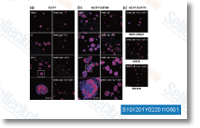Metabolites have been extracted from twenty mg of each sample with 500 uL CH3OH,H2O solution for 15 min in ultrasonic bath. Immediately after centrifuging for 10 min. at ten,000 rpm, 400 uL of supernatant was more diluted with 500 uL of CH3OH,H2O. Samples were kept at 4 C and introduced at a flow fee of 2 uL min one into the ionization supply, run in negative operation mode and hence producing mono charged ions. The spectra have been acquired using a mass to charge ratio range of 120 1,000 as well as a time domain of 1 Megaword. Spectra had been internally calibrated applying both main and secondary metabolites, calibration errors had been normally under 0. 05 ppm. Peak lists had been obtained exporting peak mass intensities of FT ICR ESI spectra using a signal to noise ratio of two. Peak lists of different samples were aligned right into a single matrix inside of a precision of 0.
seven ppm. Analysis of the metabolomic data Data were analysed working with a multivariate information analysis method applying the program package The Un scrambler. First, data have been analysed by PCA, making use of the peak record as X variable, logarith mically transformed with X log2X. The PCA was calcu lated soon after centering the information and weighting the data with one s. d. 1. Significant discriminant masses be tween selleck chemical T and S oaks, systemic and area responses, and developmentally various leaves had been searched by partial least square regression and Martens test. In the PLSR, Y values described both the genotype, or even the systemic re sponses, or the age on the leaves plus the X values contained the matrix of mass intensities using a threshold of six. 37e5.
For identifica tion of substantial discriminant masses, annotation was instantly achieved by way of selleckchem the portal MassTRIX3, by using KEGG/API. For the annotation we made use of KEGG combined with Human Metabolome Database and with expanded lipids from LipidMaps. Additionally, the struc ture of uncertain annotated metabolites was confirmed with ChemSpider. Following, the results had been filtered manually that has a maximal mass error acceptance of one. three ppm, the error caused by spectra alignment. Finally log2 ratios of mass spectra intensities had been calculated for T/S, O/Y, D/I in an effort to visualise in HeatMaps up or down regulation with the various metabolites grouped to the principal metabolic pathway in accordance to KEGG. Mapping of transcriptomic and metabolomic data to KEGG pathways The net based mostly functional annotator KAAS was made use of to map the transcript identifiers to KO numbers hence assigning the transcripts to KEGG pathways.
All metabolites had been integrated inside the pathway mapping, which showed  statisti cally considerable discriminant masses between T vs. S oaks after feeding. The selected masses have been mapped to particular metabolites in KEGG pathway displays applying MassTRIX3. Log2 fold ratios of mapped transcripts and metabolites were displayed onto the KEGG pathways in colour code.
statisti cally considerable discriminant masses between T vs. S oaks after feeding. The selected masses have been mapped to particular metabolites in KEGG pathway displays applying MassTRIX3. Log2 fold ratios of mapped transcripts and metabolites were displayed onto the KEGG pathways in colour code.
CETP Signal
CETP is a member of a class of drugs
